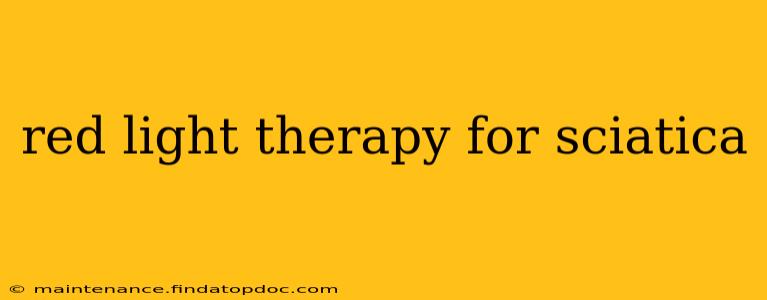Sciatica, that sharp, shooting pain radiating down your leg, can be debilitating. While many treatments exist, red light therapy (RLT) is emerging as a potential non-invasive option. But does it really work? Let's explore the science, benefits, and considerations surrounding RLT for sciatica.
What is Red Light Therapy?
Red light therapy, also known as low-level laser therapy (LLLT), uses red and near-infrared light to penetrate the skin. This light stimulates cellular activity, potentially promoting healing and reducing inflammation. Different wavelengths offer varying benefits, with red light often targeting superficial tissues and near-infrared light penetrating deeper. This non-invasive treatment is gaining popularity for various conditions, including pain management.
How Does Red Light Therapy Help with Sciatica?
The potential benefits of RLT for sciatica stem from its ability to:
- Reduce Inflammation: Sciatica often involves inflammation of the sciatic nerve. RLT may help reduce this inflammation, lessening pain and discomfort.
- Improve Blood Circulation: Increased blood flow delivers essential nutrients and oxygen to the affected area, promoting faster healing and tissue repair.
- Stimulate Cell Regeneration: RLT can stimulate the production of collagen and other proteins, aiding in tissue repair and reducing nerve pain.
- Reduce Muscle Spasms: Sciatica often accompanies muscle spasms. RLT may help relax these muscles, alleviating pain and improving mobility.
Does Red Light Therapy Really Work for Sciatica?
While anecdotal evidence and some studies suggest RLT may offer relief for sciatica, more large-scale, high-quality research is needed to definitively confirm its efficacy. Current studies show promising results, but more robust clinical trials are required to establish conclusive evidence. It's important to remember that RLT is not a standalone cure for sciatica; it's often most effective when used in conjunction with other treatments.
What are the Side Effects of Red Light Therapy for Sciatica?
RLT is generally considered safe and well-tolerated. However, some individuals may experience minor side effects, such as:
- Mild Skin Irritation: Some individuals might experience slight redness or warmth at the treatment site.
- Eye Irritation: Protecting your eyes during treatment is crucial. Never look directly into the light source.
How Often Should I Use Red Light Therapy for Sciatica?
The frequency and duration of RLT treatment for sciatica vary depending on individual needs and the severity of the condition. A healthcare professional can provide guidance on a suitable treatment plan. Generally, treatments are administered daily or several times a week for a specific period.
How Long Does it Take to See Results from Red Light Therapy for Sciatica?
The timeframe for noticing improvements varies among individuals. Some people experience relief within a few sessions, while others may require several weeks of consistent treatment. Patience and consistency are key.
Is Red Light Therapy Better Than Other Treatments for Sciatica?
RLT shouldn't be viewed as a replacement for other proven sciatica treatments. It's best used as a complementary therapy alongside conventional treatments like physical therapy, medication, or in some cases, surgery. The most effective approach depends on the individual's specific condition and severity.
What are the Costs Associated with Red Light Therapy for Sciatica?
The cost of RLT varies depending on factors like the type of device, the number of sessions, and the clinic or practitioner. At-home devices are generally more affordable than professional treatments.
Can I Use Red Light Therapy at Home for Sciatica?
Yes, at-home RLT devices are available for purchase. However, it’s crucial to choose a reputable brand and follow all safety instructions carefully. Consult a healthcare professional before starting any home treatment regimen.
Disclaimer: This information is for educational purposes only and should not be considered medical advice. Always consult with a qualified healthcare professional before starting any new treatment for sciatica or any other medical condition. They can help determine the best course of action based on your individual needs and health history.
